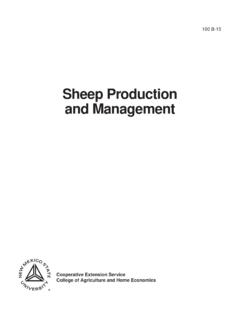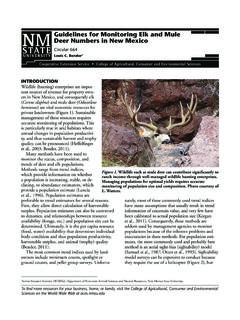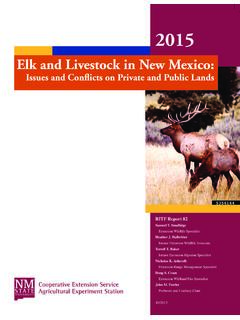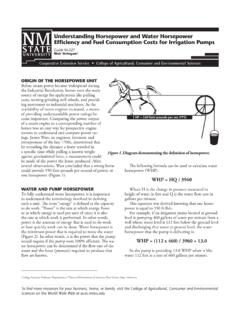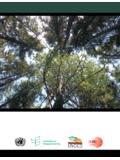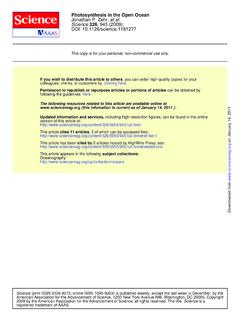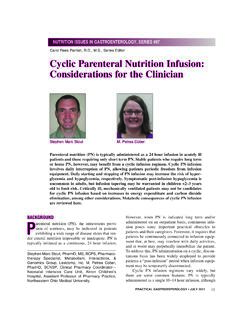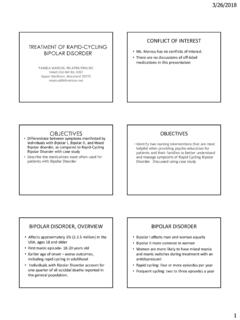Transcription of Range Management Chapter 1 Sources 4. Importance of …
1 1 Range Management Chapter 11. Range Management Terminology 2. Basic Range Management Concepts3. Range Management Information Sources4. Importance of Rangeland4. Importance of Rangelanda. Human Population Growthb. Land Area of Rangelandsc. Primary Rangeland Products5. Range Management ChallengesRange Management TerminologyRange Management - Manipulation of rangeland components to obtain optimum combination of goods and services for society on a sustained basis. Rangeland ( Range )- Uncultivated land that will provide the necessities of life for grazing and browsing animals. Multiple Use- Harmonious use of the Range for more than one purpose; livestock, wildlife, water, recreation, etc.
2 2 Grazing and rangelandsRange Management Terminology Use- Intentional grazing of the Range by more than one type of animal to obtain economic and /or social benefit. Ecology-Study of the relationship between organism or group of organisms and their environment. Economics- Study of how to allocate scarce resources among competing uses. Range Management Terminology enlarged compartment (rumen) that permits microbial degradation of food before it passes to the stomach (abomasum) [cow, deer, sheep, goat, elk, moose, etc.]Forage- All plant material on a given area potentially edible by livestock and wildlife. Grasses - Plants that have hollow; jointed stems; fine narrow leaves; and fibrous roots.
3 3 Range Management Terminology Nongrass-like plants that have tap root, broad leaves, and solid non-jointed stems. Shrubs-Woody plants that have long, coarse roots; branch near ground level; and generally have broad leaves. Trees - Woody plants that have a trunk that branches well above Range Management Concepts1. Grazing land is a renewable resource. 2. Energy from the sun can be captured by green plants which can only be harvested by the grazing Grazing land supply us with food and fiber at a very low additional energy Range Management Concepts4. The amount and kind of forage available is determined by the type of soil and the climatic conditions.
4 A given set of soil and climatic conditions define a Range site 5. Grazing lands supply us with multiple products: food, fiber, fishing, hunting, sightseeing, minerals, timber, and water. 4 Range Management Information Sources1. Society for Range ManagementFormed in 1948 PublicationsRangeland Ecology & ManagementRangelandsBooksNewslettersBroc huresSociety for Range ManagementC. AddressSociety for Range Management 445 Union BLVDL akewood, CO 80228 Website- Society for Range Management (SRM): Management Information Sources2. Textbooksa. 2005- Range Management : Principles and Practices. Holechek, Herbel, and Pieperb. 1994- Range Ecology and Management .
5 Heady and Childc. 1991- Grazing Management : An Ecological Perspective. Heitschmidt and Stuthd. 1992- Grazing Management . Vallentine. 5 Other information sourcesa. Journal of Soil and Water Conservationb. Journal of Wildlife Managementc. Journal of Animal ScienceKey Range Management Components1. Protection and enhancement of soil and vegetation complex. 2. Maintaining or improving output of consumable Range products, such as red meat, wildlife, water, wood, fiber, recreation, etc. Distinguishing feature of Range Management is that it deals with manipulating the grazing activities of large herbivores so both plant and animal production will be improved or Basic Principles in Range Management1.
6 Proper stocking Proper distribution of grazing animals. 3. Proper kinds of grazing animals. 4. Proper grazing system. *Proper stocking rate or correct animal numbers is considered the most important part of Range Management . 6 Major risks associated with rangeland livestock production in the United StatesUncertainty in outcomes of Range Management practices; disease infects livestock; predation; grasshopper infestation Biological risk Drought, severe winter Climatic risk Example Risk categoryMajor risks associated with rangeland livestock production in the United States categoryRising interest rates, falling cattle prices, rising livestock production costs, falling land valueFinancial risk Major risks associated with rangeland livestock production in the United States categoryRising taxes, increased regulation, increased grazing fees on public lands, discontinuation of subsidies, increased protection for endangered species.
7 Land use risk7 Major risks associated with rangeland livestock production in the United States , theft, vandalismOtherExampleRisk CategoryEcosystem Services Basic processes such as maintenance of air and water quality essential to human life performed by natural or near natural landscapes (ecosystems). These processes have generally been taken for granted by humans but their Importance is increasingly being recognized as the world human population increases and the world s natural landscapes diminish. Ecosystem Services (examples)a. Maintenance of air qualityb. Maintenance of water qualityc. Decomposition of waste and organic matterd.
8 nutrient cyclinge. Pollination of plants8 Ecosystem Services (examples)f. Renewal of soil fertilityg. Provision of genetic resourcesh. Natural control of pathogens and diseases i. Regulation of freshwater supplies. Ecosystems services and products1. Clean air 2. Clean water 3. Biodiversitya. Medicineb. Agriculturec. Environmental barometerd. Pest controle. Right to liveEcosystems services and products4. Esthetics 5. Food6. Ozone7. Climatic stability8. Environmental purification9. Plant products (non-food)10. Animal products (non-food)9 Importance of RangelandLand Area of Rangeland1. Composition of World Land Area30% Deserts, Glaciers, Mountain Peaks11% Farmland24% Permanent Pasture (grassland)31% Forest and Woodland3-4% Urbanize (cities, airports, highways)**70% of World Land Area is Rangeland.
9 **Rangeland is the primary land type in the Biggest Challenges of the 21st Century1. Stabilization of human Stabilization of Rangeland Issues in New Mexico1. Drought 2. Invasive Plants3. Grazing Management4. Urbanization5. Fire6. Wildlife7. Watershed Improvement11 Primary Rangeland Issues in New Mexico8. Monitoring9. Income Diversification10. Multiple Use Conflicts11. Insects/Disease12. Riparian Improvement13. Energy Development 14. Increased Regulations 15. Rangeland Restoration12
